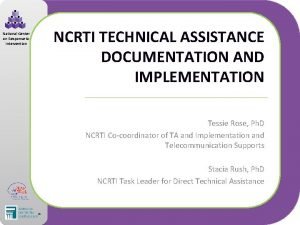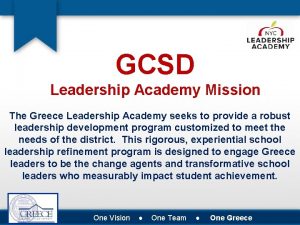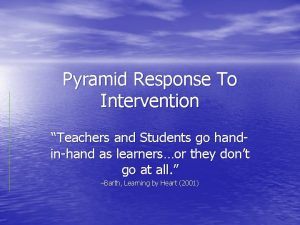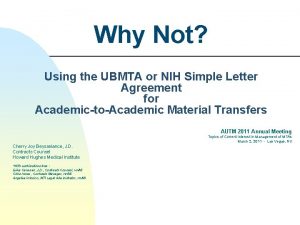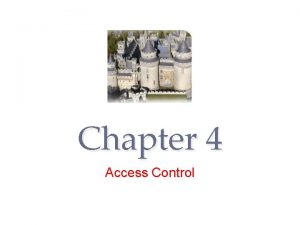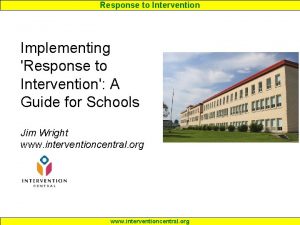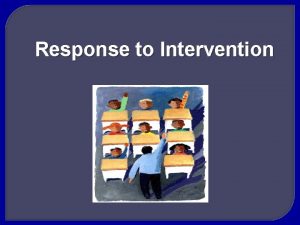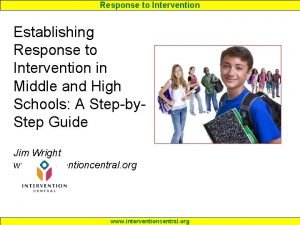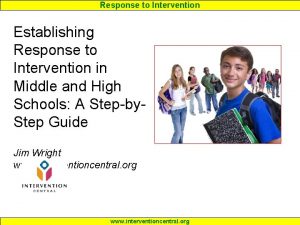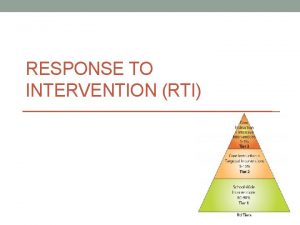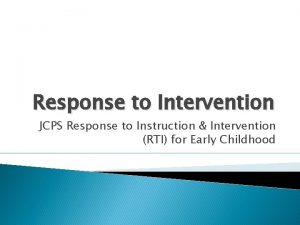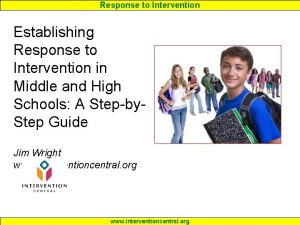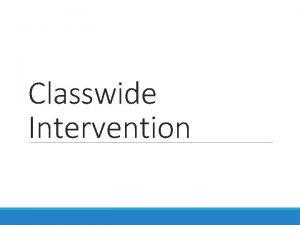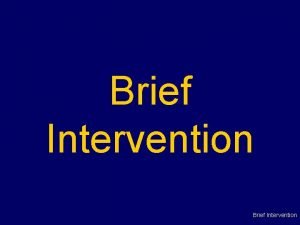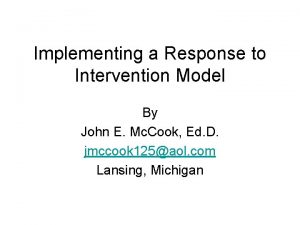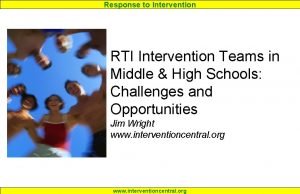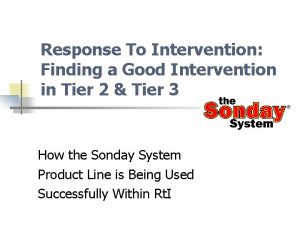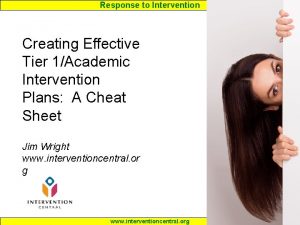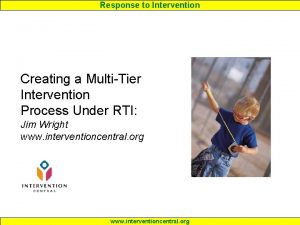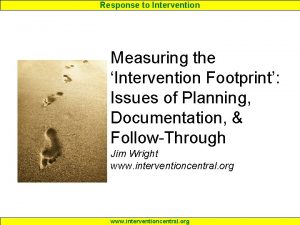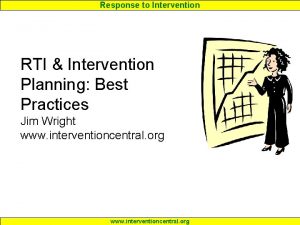Response to Intervention Implementing Response to Intervention in





















- Slides: 21

Response to Intervention Implementing Response to Intervention in Secondary Schools: Key Challenges to Changing a System Jim Wright www. interventioncentral. org

Response to Intervention Making RTI Work in Your Schools: Key Expectations www. interventioncentral. org 2

Response to Intervention Making RTI Work in Your Schools: Key Expectations • Teachers try a larger number of research-based classroom strategies before referring a student to the school’s Intervention Team. • Schools are able to find time and personnel coverage to schedule Intervention Team (IST) meetings. • The job descriptions of key people in a school change to match the needs of RTI (e. g. , school psychologist, special education teacher). • The school recognizes that RTI is an ‘umbrella’ problem=solving approach that helps the district to address a range of important school issues such as low state test scores, deficient academic skills, absenteeism, and drop-outs. www. interventioncentral. org 3

Response to Intervention Making RTI Work in Your Schools: Key Expectations (Cont. ) • Administrators show strong support for RTI, using their influence to encourage teacher follow-through with classroom interventions, helping to rework job descriptions to match RTI’s needs, etc. • RTI is accepted by the school community as a mainstream initiative, with the majority of representatives on the RTI Steering Group drawn from general education (e. g. , Curriculum Director). • RTI is given the resources that it needs to grow, including funds for staff development and for the purchase of assessment services or products and intervention materials. • The district has a multi-year plan to implement RTI that builds the model at an ambitious but sustainable www. interventioncentral. org 4

Response to Intervention Preventing Your School from Developing ‘RTI Antibodies’ • Schools can anticipate and take steps to address challenges to RTI implementation in schools • This proactive stance toward RTI adoption will reduce the probability that the ‘host’ school or district will reject RTI as a model www. interventioncentral. org 5

Response to Intervention Innovations in Education: Efficacy vs. Effectiveness “A useful distinction has recently emerged between efficacy and effectiveness (Schoenwald & Hoagwood, 2001). Efficacy refers to intervention outcomes that are produced by researchers and program developers under ideal conditions of implementation (i. e. , adequate resources, close supervision …). In contrast, effectiveness refers to demonstration(s) of socially valid outcomes under normal conditions of usage in the target setting(s) for which the intervention was developed. Demonstrations of effectiveness are far more difficult than demonstrations of efficacy. Source: Walker, H. M. (2004). Use of evidence-based interventions in schools: Where we've been, In fact, numerous promising where we are, and where we need to go. School Psychology Review, 33, 398 -407. p. 400 and approaches fail to bridge the gap www. interventioncentral. org 6

Response to Intervention Role of ‘School Culture’ in the Acceptability of Interventions “…school staffs are interested in strategies that fit a group instructional and management template; intensive strategies required by at-risk and poorly motivated students are often viewed as cost ineffective. Treatments and interventions that do not address the primary mission of schooling are seen as a poor match to school priorities and are likely to be rejected. Thus, intervention and management approaches that are universal in nature and that involve a standard dosage that is easy to deliver (e. g. , classwide social skills training) have a higher likelihood of making it into routine or Source: Walker, H. M. (2004). school Use of evidence-based interventions in schools: Where we've been, standard practice. ” where we are, and where we need to go. School Psychology Review, 33, 398 -407. pp. 400 -401 www. interventioncentral. org 7

Response to Intervention Barriers in Schools to Innovations in Interventions “Factors that have been identified as barriers to … acceptance and implementation by educators [of effective behavioral interventions for at at-risk students] include characteristics of the host organization, practitioner behavior, costs, lack of program readiness, the absence of program champions and advocates within the host organization, philosophical objections, lack of fit between the program's key features and organizational routines and Source: Walker, H. M. (2004). Useand of evidence-based interventions in schools: Where we've been, operations, weak staff participation. ” where we are, and where we need to go. School Psychology Review, 33, 398 -407. p. 400 www. interventioncentral. org 8

Response to Intervention RTI: Research Questions Q: What Conditions Support the Successful Implementation of RTI? RTI requires: • Continuing professional development to give teachers the skills to implement RTI and educate new staff because of personnel turnover. • Administrators who assert leadership under RTI, including setting staff expectations for RTI implementation, find the needed resources, and monitor the fidelity of implementation. • Proactive hiring of teachers who support the principles of RTI and have the skills to put RTI into practice in the classroom. • The changing of job roles of teachers and support staff (school psychologists, reading specialists, special educators, etc. ) to support the RTI model. • Input from teachers and support staff (‘bottom-up’) about how to make RTI work in the school or district, as well as guidance from Source: Fuchs, D. , & Deshler, D. D. (2007). What we need to know about responsiveness to intervention administration (‘top-down’). (and shouldn’t be afraid to ask). . Learning Disabilities Research & Practice, 22(2), 129– 136. www. interventioncentral. org 9

Response to Intervention RTI/Secondary: ‘Top 10 Tasks’ for Implementing RTI at the Middle & High School Level www. interventioncentral. org 10

Response to Intervention 1 RTI Secondary ‘Top 10’ Tasks: My middle or high school has: Screening procedures in place to locate students at risk. The school institutes procedures and decision rules to identify students who should be referred to the RTI Team for academic or behavioral concerns. For example, the school may • monitor 5 - and 10 -week grade reports and refer any student who receives two or more failing grades. • track office disciplinary referrals and refer students with repeated referrals who have not responded positively to lesser forms of intervention such as administrator/parent conference. • maintain a ‘watch list’ of at-risk students from year to year, including students transferring www. interventioncentral. org 11

Response to Intervention 2 RTI Secondary ‘Top 10’ Tasks: My middle or high school has: Put into place a formal process for Tier II (RTI Team) referrals. The school has a defined process in place for referring students to the RTI Team. That referral process includes these elements: • Student referrals can originate from a number of sources (e. g. , classroom teachers, school psychologists, guidance counselor, administration, parent, etc. ). • People who can refer students understand the profile of academic or behavioral concerns that warrant referring a student to the RTI Team. • The school designates a small number of contact people (e. g. , school psychologist, guidance counselors, school administration) www. interventioncentral. org 12

Response to Intervention 3 RTI Secondary ‘Top 10’ Tasks: My middle or high school has: Reached a shared understanding among faculty about how to provide Tier I interventions in a consistent manner across classrooms. Standardizing Tier I interventions across the school requires: • Consensus regarding the minimum effort that is reasonable for teachers to expend in Tier I (classroom) interventions • Creation of a menu of feasible classroom strategies to address common student concerns such as lack of organization skills or limited reading comprehension • Provision of staff development, coaching and other support to teachers initially to www. interventioncentral. org encourage their adoption of an expanded 13

Response to Intervention RTI Secondary ‘Top 10’ Tasks: My middle or high school has: • • • 4 • Created consistent and fair policies throughout the school for homework assignments and acceptance of late work. Ideas to be considered for a schoolwide homework/late work policy include: Setting a reasonable cap on the amount that homework counts toward the course grade (e. g. , 1020 percent). Establishing guidelines across classrooms for the acceptance of late work, including penalties and conditions (such as illness) under which those penalties are to be waived. Requiring that all teachers hand out periodic (e. g. , weekly) outlines detailing all upcoming classwork and homework assignments. Allowing the RTI Team latitude on a case-by-case basis to modify a student’s homework expectations or allow an extension in the acceptance of late student www. interventioncentral. org 14

Response to Intervention 5 RTI Secondary ‘Top 10’ Tasks: My middle or high school RTI Team has: Created an RTI Team (Tier Ii) that follows an efficient problem-solving model. The school has established a multi-disciplinary team that meets regularly to discuss student referrals. This ‘RTI Team: : • Follows a consistent, structured problemsolving model. • Schedules initial meetings to discuss student concerns and follow-up meetings to review student progress and judge whether the intervention plan was effective. • Develops written intervention plans with sufficient detail to ensure that the intervention is implemented with fidelity across settings and people. www. interventioncentral. org 15

Response to Intervention RTI Secondary ‘Top 10’ Tasks: My middle or high school RTI Team has: 6 Identified RTI-relevant ‘extant’ data to be routinely brought to RTI Team meetings. The RTI Team surveys the data already collected and stored by the school (‘extant data’) and decides (1) what specific data should routinely be brought to RTI Team meetings and (2) who is responsible for bringing it. Examples of data that would be useful at initial intervention team meetings include: • Attendance records • Current quiz, test, and homework grades • Office disciplinary referral information. www. interventioncentral. org 16

Response to Intervention 7 RTI Secondary ‘Top 10’ Tasks: My middle or high school RTI Team has: Inventoried intervention resources available in the building or district for use by the RTI Team. The inventory should include: • Formal programs or services available to atrisk students • Specific personnel with specialized training in academic or behavioral interventions (who can serve as consultants or coaches to teachers) • Curriculum materials – including computerassisted instructional or remedial programs— that can be included in student intervention plans when appropriate. Once inventoried, intervention resources should www. interventioncentral. org 17

Response to Intervention 8 RTI Secondary ‘Top 10’ Tasks: My middle or high school RTI Team has: Mapped adolescent and family services offered by local human-services agencies. Through the RTI Team or other vehicle, the school has: • Surveyed the range of relevant agency services or programs offered in the community that target adolescents or families. • Identified referral procedures and key contacts in local agencies to access their programs or services. • Developed the capability (with agency and family/student agreement) to invite agency www. interventioncentral. org 18

Response to Intervention 9 RTI Secondary ‘Top 10’ Tasks: My middle or high school RTI Team has: A process to train students to be selfadvocating, self-managing learners. The school recognizes that students have important responsibilities in middle and high school interventions. To accomplish this goal, the school: • Provides training to students in how to analyze their learning needs and advocate for those needs. • Creates the expectation that students will be invited to RTI Team meetings when appropriate. • Develops a student ‘intervention contract’ listing those elements of the intervention plan www. interventioncentral. org 19

Response to Intervention RTI Secondary ‘Top 10’ Tasks: My middle or high school RTI Team has: The capacity to monitor student progress during interventions. The RTI Team has the capacity using reliable, valid measures to track student progress in response to intervention plans and can make data-based decisions within several weeks whether those plans are effective. 1 www. interventioncentral. org 20

Response to Intervention Team Activity: Create an RTI Secondary Action Plan In your elbow groups: 1. Review the RTI Readiness Inventory--‘Top 10 Tasks’ for Implementing RTI at the Middle & High School Level. 2. Select the top 2 -3 areas that you would like to work on in the coming school year to implement an RTI model in your secondary school. 3. Be prepared to share main points of your discussion. www. interventioncentral. org 21
 National center for response to intervention
National center for response to intervention Ncrti
Ncrti Simplifying response to intervention
Simplifying response to intervention Pyramid response to intervention
Pyramid response to intervention Implementing strategies management and operations issues
Implementing strategies management and operations issues Tripod pricing strategy
Tripod pricing strategy Implementing strategies management and operations issues
Implementing strategies management and operations issues Stages in implementing portfolio assessment
Stages in implementing portfolio assessment Ubmta implementing letter
Ubmta implementing letter Management issues central to strategy implementation
Management issues central to strategy implementation Finance and accounting issues in strategy implementation
Finance and accounting issues in strategy implementation Implementing merchandise plans
Implementing merchandise plans Toyota brand architecture
Toyota brand architecture Planning and implementing crm projects
Planning and implementing crm projects Emap
Emap Mis issues in strategy implementation
Mis issues in strategy implementation Is the traditional method of implementing access control
Is the traditional method of implementing access control Designing and implementing brand strategies
Designing and implementing brand strategies Implementing nfpa 1600 national preparedness standard
Implementing nfpa 1600 national preparedness standard Challenges of implementing predictive analytics
Challenges of implementing predictive analytics Qsen competencies
Qsen competencies Stateful firewall
Stateful firewall

